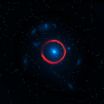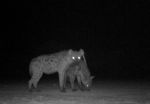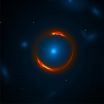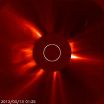(Press-News.org) When a batch of bright cosmic objects first appeared in maps in 2008 made with data from the South Pole Telescope, astronomers at the University of Chicago's Kavli Institute for Cosmological Physics regarded it only as an unavoidable nuisance.
The light sources interfered with efforts to measure more precisely the cosmic microwave background—the afterglow of the big bang. But the astronomers soon realized that they had made a rare find in South Pole Telescope's large survey of the sky. The spectra of some of the bright objects, which is the rainbow of light they emit, were inconsistent with what astronomers expected from the well-known population of radio galaxies.
Instead they looked like dust-enshrouded, star-forming galaxies. Such galaxies should be easily identified in infrared sky surveys, but there were no known counterparts for what the South Pole Telescope had found. They had to be extremely distant to avoid infrared detection, and therefore extremely luminous. Intrigued, the astronomers performed detailed follow-up imaging of the sources with the new Atacama Large Millimeter Array (ALMA) in Chile's Atacama Desert. These observations show the dust-filled galaxies were bursting with stars much earlier in cosmic history than previously thought.
Joaquin Vieira, now a postdoctoral scholar at the California Institute of Technology, leads a team that will report the discovery in the March 14 issue of the journal Nature and in two other papers that will appear in the Astrophysical Journal.
"We have been eagerly waiting for ALMA to be ready so we could conduct these observations," said Vieira, MS'05, PhD'09, who based his doctoral research at UChicago on the discovery of the extragalactic sources. "The sources we discovered with [the South Pole Telescope] were so far in the southern sky that no telescopes in the Northern Hemisphere could observe them. We are very privileged to be among the first astronomers to use ALMA."
Vieira has supported the South Pole Telescope from the beginning, helping to build the telescope and its camera, said John Carlstrom, S. Chandrasekhar Distinguished Service Professor in Astronomy & Astrophysics at UChicago. "He's been involved from the ground up, or the ice up, if you will," said Carlstrom, who leads the SPT collaboration and is a co-author of the Nature paper.
Prodigious star production
The starburst galaxies produce stars at a prodigious rate, creating the equivalent of a thousand new suns annually. Vieira and his colleagues have found starbursts that were churning out stars when the universe was just a billion years old. Previously astronomers were unsure whether galaxies could form new stars so quickly at this very early point in the history of the universe.
Shining with the energy of a trillion suns or more, these newly discovered galaxies are observed as they were nearly 12 billion years ago, showing us a representative baby picture of the most massive galaxies in Earth's cosmic neighborhood today. "The more distant the galaxy, the further back in time one is looking, so by measuring their distances, we can piece together a timeline of how vigorously the universe was making new stars at different stages of its 13.7-billion-year history," Vieira said.
The astronomers found dozens of these galaxies with the South Pole Telescope, a 10-meter dish in Antarctica that surveys the sky in millimeter-wavelength light (situated between radio and the infrared on the electromagnetic spectrum). The team then took a more detailed look using ALMA in Chile. "These aren't normal galaxies," Vieira said. "They're forming stars at an extraordinary rate when the universe was very young—we were very surprised to find galaxies like this so early in the history of the universe."
The new observations represent some of ALMA's most significant scientific results yet, Vieira said. "We couldn't have done this without the combination of [the South Pole Telescope] and ALMA," he added. "ALMA is so sensitive, it is going to change our view of the universe in many different ways."
The astronomers used only 16 of 66 dishes that will eventually come online for ALMA, which is the most powerful telescope observing in millimeter and sub-millimeter wavelengths. ALMA began observing last year.
ALMA data analysis
Analysis of the ALMA data showed that more than 30 percent of the new galaxies existed just a billion years after the big bang. Only nine such galaxies were known previously. The number of such galaxies now has nearly doubled, providing valuable data that will help other researchers constrain and refine computer models of star and galaxy formation in the early universe.
Vieira's team directly determines the distance of these dusty starburst galaxies from emission from their gas and dust itself. Astronomers previously had to rely on a cumbersome combination of indirect optical and radio observations using multiple telescopes to study the galaxies. But ALMA's unprecedented sensitivity and ability to measure spectra enabled the astronomers to make their observations and analyze them directly in one step. As a result, the new distances are more reliable and represent the best sample yet of this population of early galaxies.
The unique properties of these objects also enabled the measurements. First, the observed galaxies happened to be gravitationally lensed—a phenomenon predicted by Einstein in which another galaxy in the foreground bends the light from the background galaxy like a magnifying glass. This lensing effect makes the background galaxies appear brighter, cutting the amount of telescope time needed to observe them by 100 times.
Second, the astronomers took advantage of a fortuitous feature of these galaxies' spectra. Normally, more distant galaxies appear dimmer. But it turns out that the expanding universe shifts the emitted spectra in such a way that the light we receive at millimeter wavelengths is not diminished for sources that are more distant from us. Consequently, the galaxies appear just as bright in these wavelengths no matter their distance.
The new results represent approximately a quarter of the total number of sources that Vieira and his colleagues discovered with the South Pole Telescope. They anticipate finding more of the dusty starburst galaxies and expect some to be from even earlier times in the universe as they continue analyzing their data.
INFORMATION:
— Steve Koppes and Marcus Woo
UChicago scientists contributing to the March 13 Nature paper are faculty members John Carlstrom, Mike Gladders and Steve Meyer; senior researchers Bradford Benson, Clarence Chang, Tom Crawford and Kathryn Schaffer; associate fellows Will High, Stephen Hoover, Ryan Keisler and Tom Plagge; associate Steve Padin; research associate Keren Sharon; and graduate students Lindsey Bleem, Monica Mocanu, Tyler Natoli and Kyle Story.
The South Pole Telescope is funded primarily by the National Science Foundation's Office of Polar Programs. Partial support also is provided by the NSF-funded Physics Frontier Center of UChicago's Kavli Institute for Cosmological Physics, the Kavli Foundation, and the Gordon and Betty Moore Foundation.
'Nuisance' data lead to surprising star-birth discovery
2013-03-14
ELSE PRESS RELEASES FROM THIS DATE:
Carnivores, livestock and people manage to share same space study finds
2013-03-14
In the southern Rift Valley of Kenya, the Maasai people, their livestock and a range of carnivores, including striped hyenas, spotted hyenas, lions and bat-eared foxes, are coexisting fairly happily according to a team of coupled human and natural systems researchers.
"I wouldn't call the results surprising," said Meredith Evans Wagner, a visiting scholar from the University of Florida in the Center for Systems Integration and Sustainability (CSIS) at Michigan State University and part of the research team. "Other research has shown that people and carnivores can coexist, ...
Bursts of star formation in the early universe
2013-03-14
PASADENA, Calif.—Galaxies have been experiencing vigorous bursts of star formation from much earlier in cosmic history than previously thought, according to new observations by a Caltech-led team.
These so-called starburst galaxies produce stars at a prodigious rate—creating the equivalent of a thousand new suns per year. Now the astronomers have found starbursts that were churning out stars when the universe was just a billion years old. Previously, astronomers didn't know whether galaxies could form stars at such high rates so early in time.
The discovery enables ...
1 in 4 colonoscopies in Medicare patients found to be potentially inappropriate
2013-03-14
Colonoscopy is one of the most effective cancer screening procedures available. Colon cancer grows very slowly and can be treated if caught early through screening. But, perhaps because of this success, older Americans are undergoing screening colonoscopies despite recommendations against screening in adults aged 76 and older.
A new study by researchers at the University of Texas Medical Branch at Galveston published online today in JAMA Internal Medicine shows that one out of four colonoscopies paid for by Medicare is potentially inappropriate under current screening ...
More accurate, sensitive DNA test allows early identification of fungus causing WNS
2013-03-14
MADISON, Wis., March 13, 2013 – Even after researchers studying White Nose Syndrome (WNS) established that a fungus called Geomyces destructans is at the heart of the devastating disease, detecting it depended largely on finding dead or dying bats.
This month, the journal Mycologia will publish research by a team of U.S. Forest Service scientists and partners identifying additional species of Geomyces and describing development of a highly sensitive DNA-based technique for early identification of Geomyces destructans on bats as well as in soils and on cave walls.
"The ...
Symbols, such as traffic lights, on menus effective in educating diners
2013-03-14
CHAMPAIGN, Ill. — A little-noticed provision of the Affordable Care Act requires all chain restaurants and retail food establishments with 20 or more locations to list calorie counts on their menus. But according to research co-written by a University of Illinois agricultural economist, numeric calorie labels might not be the most effective way to influence patrons to select "healthier" (often interpreted as lower-calorie) items.
Brenna Ellison, a professor of agricultural and consumer economics, says placing a symbolic label in addition to the numeric calorie information ...
NASA sees large decrease in Cyclone Sandra's rainfall intensity
2013-03-14
NASA's Tropical Rainfall Measuring Mission satellite, also known as TRMM, flew over Cyclone Sandra twice in one day and noticed a large decrease in rainfall intensity over a nine hour period.
On March 11, 2013, NASA's TRMM satellite twice flew above weakening tropical cyclone Sandra as it was passing to the west of New Caledonia in the southern Pacific Ocean. TRMM's Precipitation Radar (PR) had a very good view of Sandra as it passed directly above the tropical cyclone on March 11 at 1312 UTC (9:12 a.m. EST). TRMM PR measured rainfall at the extreme rate of over 206 mm ...
Dwelling on stressful events can increase inflammation in the body, study finds
2013-03-14
ATHENS, Ohio (March 13, 2013)—Dwelling on negative events can increase levels of inflammation in the body, a new Ohio University study finds.
Researchers discovered that when study participants were asked to ruminate on a stressful incident, their levels of C-reactive protein, a marker of tissue inflammation, rose. The study is the first time to directly measure this effect in the body.
"Much of the past work has looked at this in non-experimental designs. Researchers have asked people to report their tendency to ruminate, and then looked to see if it connected to physiological ...
Scientists discover novel chemical that controls cell behavior
2013-03-14
March 12, 2013 — Albuquerque, NM (UNM Cancer Center) — It's the spread of the original cancer tumor that kills most people. That's why cancer researchers vigorously search for drugs that can prevent metastases, the spread of cancer. The research team co-led by Angela Wandinger-Ness, PhD, and Larry Sklar, PhD, at the University of New Mexico Cancer Center has found a chemical compound that appears to control cell migration and adhesion, two important characteristics of metastatic cancer cells. The team recently published a paper describing how the first-in-class compound ...
Sun spits out 2 CMEs
2013-03-14
The sun recently erupted with two coronal mass ejections (CMEs). One began at 8:36 p.m. EDT on March 12, 2013 and is directed toward three NASA spacecraft, Spitzer, Kepler and Epoxi. There is, however, no particle radiation associated with this event, which is what would normally concern operators of interplanetary spacecraft since the particles can trip computer electronics on board. A second CME began at 6:54 a.m. EDT on March 13, 2013 and its flank may pass by Earth at a speed that does not typically have a significant impact at Earth.
Experimental NASA research models, ...
Vitamin D may lower blood pressure in African-Americans
2013-03-14
Boston – High blood pressure, a risk factor for heart attacks, heart failure and stroke, is 40 percent more common in African-Americans than in other American ethnic groups. In a new study from Brigham and Women's Hospital (BWH), along with the Dana-Farber Cancer Institute and Massachusetts General Hospital, researchers show that vitamin D supplementation may help African-Americans lower their blood pressure. The study publishes online in the March 13, 2013 edition of the American Heart Association journal Hypertension.
"This study may explain and help treat an important ...





